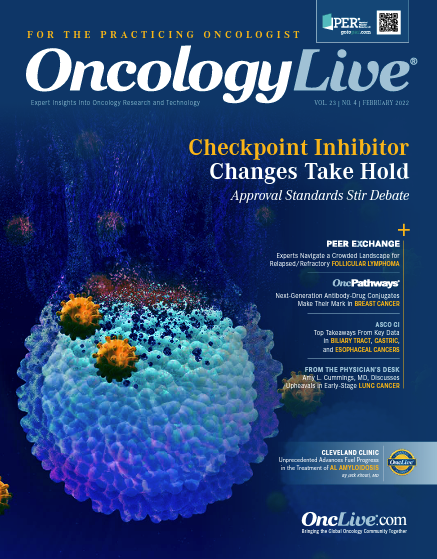First-in-Class AR Agonist Opens Doors for ER-Positive Metastatic Breast Cancer
Androgen recepter positivity serves as an independent predictor of beneficial outcomes in breast cancer.
Lee S. Schwartzberg, MD, FACP

Androgen recepter (AR) positivity serves as an independent predictor of beneficial outcomes in breast cancer. Although AR is expressed in up to 90% of patients with estrogen receptor (ER)-positive breast cancer, successful efforts to optimize it in this population have been limited. However, early preclinical data have uncovered a new approach for leveraging AR, representing a potential opportunity to fill the unmet need for patients with ER-positive disease who have exhausted available treatments.1,2
Data from patient-derived models showed that AR agonism, rather than antagonism, durably inhibited tumor growth, contextualizing why progress incorporating AR-targeted therapies has been constrained.2 Investigators concluded that this finding illuminates the potential role for AR in ER-positive breast cancers with the development of selective AR agonists.
“The way that AR works in an ER-positive cell has been a mystery and is not completely clear,” said Lee S. Schwartzberg, MD, FACP, in an interview with OncologyLive®. “We now believe that in [patients who have] hormone receptor–positive disease, the AR functions more as a tumor suppressor gene. It’s not [as though] if you suppress ER, as we do with most of our endocrine therapies, that the androgen turns on like it does in prostate cancer. It seems to have a different role in this group of patients. In the past, we’ve tested blockers of AR based on what was probably an erroneous principle—that it could be a resistance mechanism by signaling through AR as opposed to hormone receptor. We used drugs like enzalutamide [Xtandi] and other drugs that inhibited androgens either directly or [through] the production of androgens like fulvestrant [Faslodex], which were also used in the past. It turned out [that those drugs] didn’t have a great benefit in that setting.”
In an effort to develop a new class of agents to test this preclinical hypothesis, investigators developed enobosarm, a first-in-class, novel oral selective AR-targeting agonist. “In AR-positive, hormone receptor–positive preclinical models, enobosarm has a profound effect at inhibiting the growth of cancers, and that’s true in cell lines that are estrogen sensitive and estrogen resistant,” said Schwartzberg, chief medical officer and a board member at OneOncology. He added that data from mouse models also demonstrated that enobosarm combines well with CDK4/6 inhibitors, which led to the rationale to carry the agent over to in-human studies for patients with metastatic breast cancer.2
Establishing a Path Forward for AR Agonists
Investigators initiated trials for patients with AR-positive metastatic breast cancer, including those with triple-negative breast cancer. “The AR [tumor suppressor pathway] is intriguing,” Sara M. Tolaney, MD, MPH said. “In data for enobosarm we saw that there was robust clinical benefit from this agent in pretreated hormone receptor–positive breast cancer. What we saw was that the activity was even greater when you looked at patients who had high AR expression. The investigators used an AR expression cutoff of greater than or equal to 40% and that’s where they started seeing their objective responses.” Tolaney is chief of the Division of Breast Oncology and associate director at Susan F. Smith Center for Women’s Cancers, a senior physician at Dana-Farber Cancer Institute, and an associate professor of medicine at Harvard Medical School in Boston, Massachusetts.
Sara M. Tolaney, MD, MPH

Data from 2 trials in particular concerning AR-positive, ER-positive metastatic breast cancer provided the rationale for commencing a phase 3 trial. First, in a phase 2, single-arm, proof-of-concept study (NCT01616758), investigators examined enobosarm at a dose of 9 mg daily for the treatment of patients with AR-positive, ER-positive advanced breast cancer. The primary end point, clinical benefit rate (CBR) at 24 weeks, was met at 35.3% (90% CI, 16.6%-58%) among 22 treated patients. At day 84, the progression-free probability was 57.7% and was 50.5% at day 168; the 6-month Kaplan-Meier estimate for progression-free survival (PFS) was 43.8%.3 In terms of safety, the agent was well tolerated with no significant virilizing effects and no reported liver toxicity.
In a second phase 2 study (NCT02463032), investigators evaluated patients with heavily pretreated AR-positive, ER-positive, HER2-negative metastatic breast cancer who had progressed after treatment with multiple lines of endocrine therapy. The open-label, multinational trial enrolled 136 postmenopausal women to be treated with enobosarm 9 mg (n = 72) or enobosarm 18 mg (n = 64). The primary efficacy end point of the study was to determine CBR by RECIST 1.1 criteria at 6 months.1
The median age in the 9-mg cohort was 60.5 years (range, 35-83) and 62.5 years (range, 42-81) in the 18-mg cohort. Prior chemotherapy had been administered in 90% and 92.3% of patients in the 9-mg group (n = 50) and the 18-mg group (n = 52), respectively. The median number of prior lines of endocrine therapy among all patients was 3.
Among those in the 9-mg cohort, the CBR at 24 weeks was 32% (95% CI, 19.5%-46.7%). The 24-week CBR in the 18-mg cohort (n = 52) was 29% (95% CI, 17.1%-43.1%).1
Investigators observed a correlation between radiographic PFS (rPFS) and AR nuclei staining. In an exploratory analysis, they determined that 40% AR staining was the optimal cutoff. The median rPFS for patients with greater than 40% AR staining (n = 24) was 5.5 months compared with 2.75 months among patients with less than 40% AR staining (n = 22). The ORR was 50% vs 0%, respectively, and the CBRs were 79% vs 18%, respectively (P < .0001).1
In terms of safety, most adverse effects (AEs) reported in the study were grade 1/2. Serious AEs occurred at a rate of 10.7% vs 16.4% in the 9-mg arm and 18-mg arm, respectively.
“The 9-mg dose turned out to be the better dose; it was a little less toxic and had at least as good activity with numerically better efficacy than the 18-mg dose,” said Schwartzberg. “Enobosarm is clearly an active agent that has relatively little toxicity. Most of the AEs that were seen in that phase 2 trial were mostly grade 1 and 2; there were a few increased liver function tests from enobosarm, and hypercalcemia was seen in some patients. That was the dose-limiting toxicity early on, but that was only seen in a couple of patients and was easily managed.”
Based on these data, the dose for phase 3 trials was determined to be 9 mg and the threshold for AR positivity was set at a minimum of 40% AR nuclei staining. Schwartzberg noted that testing for AR is commercially available. “It’s used in other diseases such as prostate cancer [and] can be done in any pathology lab,” he said.
Validating Enobosarm for Clinical Use
In the phase 3 ARTEST trial (NCT04869943), investigators are examining the efficacy of enobosarm vs physician’s choice of endocrine therapy in patients with AR-positive, ER-positive, and HER2-negative metastatic breast cancer who have experienced tumor progression after treatment with estrogen-blocking agents and CDK 4/6 inhibitors (FIGURE).4 Physician’s choice therapy includes treatments such as exemestane, exemestane and everolimus (Afinitor), or selective ER modulators including tamoxifen.
Enobosarm for the Treatment of AR-positive, ER-positive, HER2-negative MBC

The primary end point of the trial is median rPFS defined by RECIST 1.1 criteria. The secondary end point is objective response rate. Eligibility criteria for the study include an ECOG performance status of 2 or lower and at least 2 prior lines of therapy including treatment with an aromatase inhibitor and fulvestrant, both as either a monotherapy or in combination with another treatment. At least one of the therapies must have been administered in combination with a CDK4/6 inhibitor.4 Of note, participants may have received 1 course of chemotherapy in the adjuvant or neoadjuvant setting which would not count as a line of therapy.
“If enobosarm shows activity that is better than the endocrine therapy of physician’s choice as an active control, this will become an important treatment modality in our armamentarium,” Schwartzberg said. “Despite the excellent advances with CDK4/6 inhibitors, and now the oral SERDs [selective estrogen receptor degraders] that are coming out, none of these drugs are going to be curative. We also know now that patients do very well with endocrine therapy for a prolonged period. If we can get another agent that works in a completely different mechanism for these patients who are ER positive, we can potentially prolong their time to live and prolong their time until they need chemotherapy. Everyone agrees that endocrine therapy is kinder and gentler and often more effective than chemotherapy in this large subgroup of patients who are ER positive, HER2 negative with advanced breast cancer.”
The first patient was enrolled in the ARTEST trial in October 2021.5 On January 10, 2022, Veru Inc, the developer of enobosarm, announced that the FDA had granted a fast track designation to the phase 3 registration program for the agent.6
“We always need to look back into history and try to elevate some of the seminal clinical observations that were made in the past and repurpose them now in a modern era. Enobosarm is an evolution of what we knew 40 years ago in breast cancer—that the androgen axis is important and can be manipulated to improve the outcomes of some patients with breast cancer. I’m very excited about [the research that’s to come],” said Schwartzberg.
References
- Palmieri C, Linden HM, Birrell S, et al. Efficacy of enobosarm, a selective androgen receptor (AR) targeting agent, correlates with the degree of AR positivity in advanced AR+/estrogen receptor (ER)+ breast cancer in an international phase 2 clinical study. J Clin Oncol. 2021;39(suppl 15):1020. doi:10.1200/ JCO.2021.39.15_suppl.1020
- Hickey TE, Selth LA, Chia KM, et al. The androgen receptor is a tumor suppressor in estrogen receptor–positive breast cancer. Nat Med. 2021;27(2):310-320. doi:10.1038/s41591-020-01168-7
- Overmoyer B, Sanz-Altamira P, Taylor RP, et al. Enobosarm: a targeted therapy for metastatic, androgen receptor positive, breast cancer. J Clin Oncol. 2014;32(suppl 15):568. doi:10.1200/ jco.2014.32.15_suppl.568
- Efficacy evaluation of enobosarm monotherapy in treatment of AR+/ER+/HER2- metastatic breast cancer (ARTEST). January 31, 2022. Accessed February 1, 2022. https://clinicaltrials.gov/ ct2/show/NCT04869943
- Veru enrolls first patient in international phase 3 ARTEST clinical trial enobosarm in metastatic breast cancer. News release. Veru Inc. October 13, 2021. Accessed February 1, 2022. bit.ly/34cYOV9
- Veru announces FDA grant of fast track designation for enobosarm for the treatment of AR+ ER+ HER2- metastatic breast cancer. News release. Veru Inc. January 10, 2022. Accessed February 1, 2022. bit.ly/3L3fvmw




